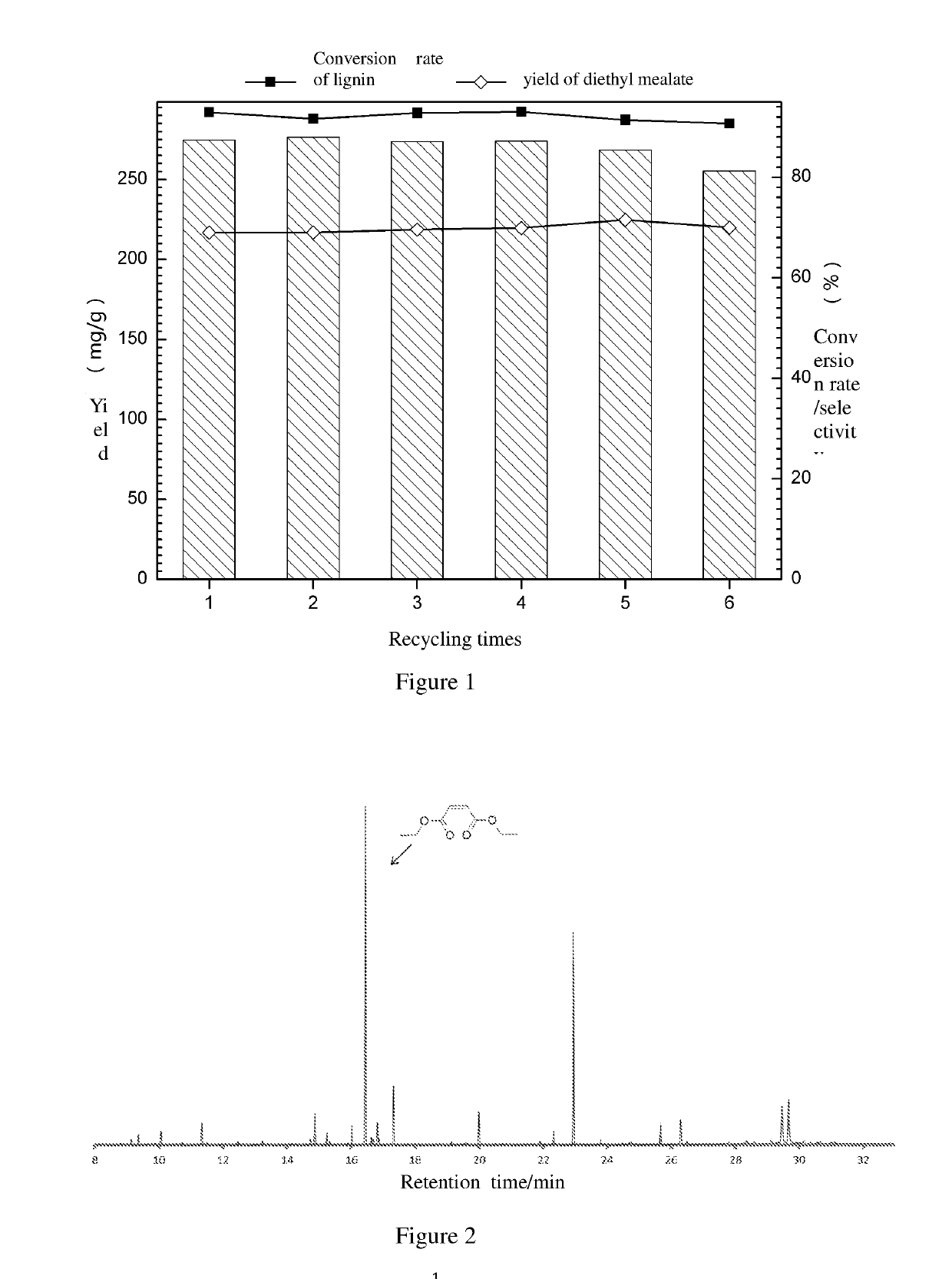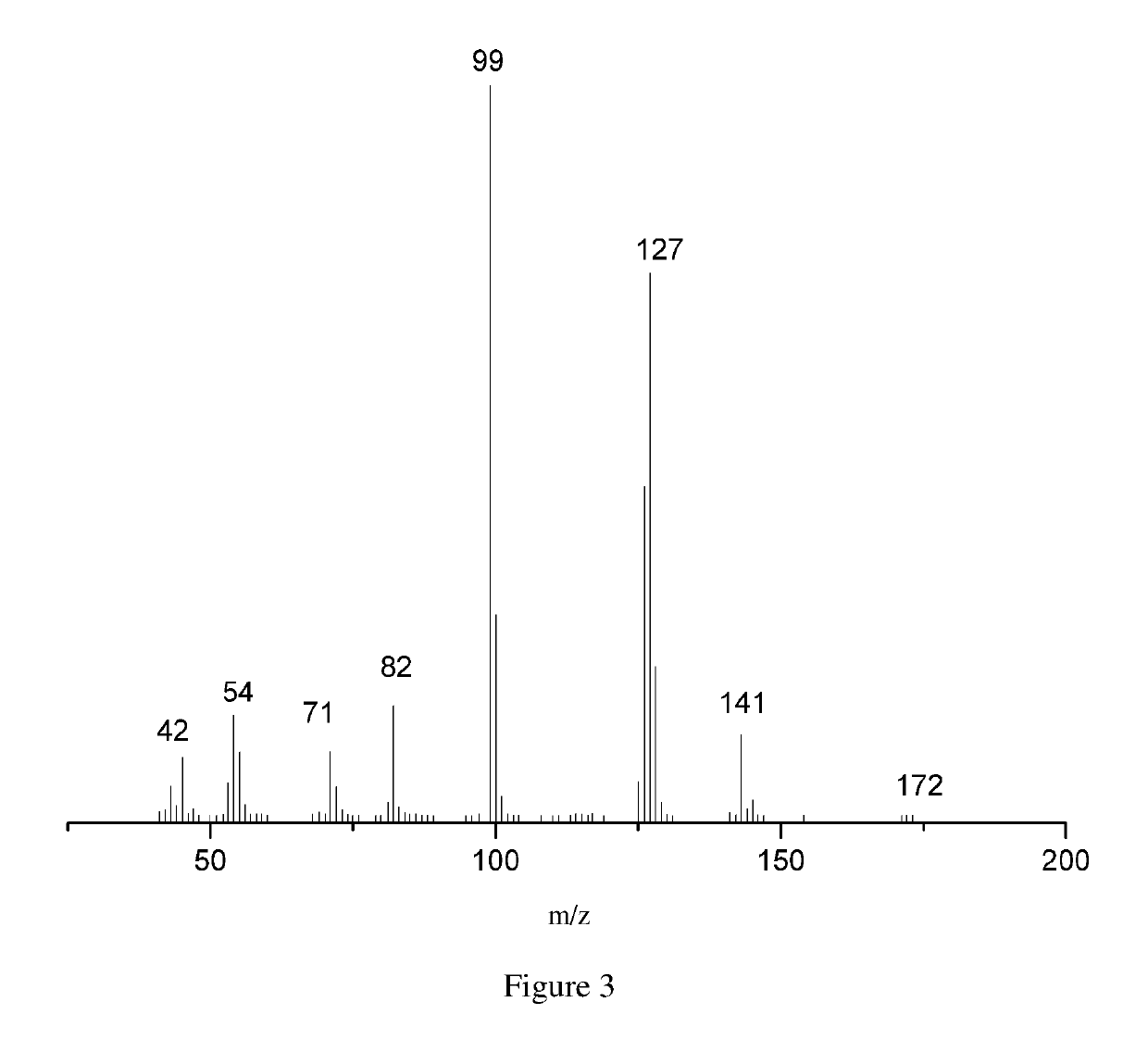Method for preparing maleate by selective catalytic oxidation of lignin
a selective catalytic and lignin technology, applied in the field of high-selectivity conversion of lignin, can solve the problems of difficult reaction, process always requires harsh reaction conditions, and high selectivity, and achieves simple catalyst preparation method, good catalytic activity, and simple process
- Summary
- Abstract
- Description
- Claims
- Application Information
AI Technical Summary
Benefits of technology
Problems solved by technology
Method used
Image
Examples
example 1
[0034]1. Preparation of Ionic Liquid BSmimCuPW12O40:
[0035](1) Weighing an equimolar amount of N-methylimidazole and 1,4-butane sultone and reacting at 50° C. for 24 h; after the reaction, washing with diethyl ether and drying under vacuum at 60° C. to obtain a white solid internal salt;
[0036](2) dissolving the phosphotungstic acid in deionized water, stirring until the phosphotungstic acid is completely dissolved; weighing basic copper carbonate with half of the molar amount of phosphotungstic acid, slowly adding to the phosphotungstic acid solution, stirring at room temperature for 24 h to obtain a light blue solution; then removing the solvent by a rotary evaporator at 80° C., conducting vacuum drying at 60° C. for 12 h to obtain a heteropolyacid CuHPW12O40;
[0037](3) weighing an equimolar amount of the heteropolyacid CuHPW12O40 and the inner salt prepared in step (1), dissolving the heteropolyacid CuHPW12O40 and the inner salt in deionized water, respectively, then dropwise adding...
example 2
[0045]The difference between Example 2 and Example 1 is:
[0046]1. Preparation of Ionic Liquid 1-(4-sulfobutyl)-3-ethylimidazolium phosphotungstate Nickel salt BSeimNiPW12O40:
[0047](1) Weighing an equimolar amount of N-ethylimidazole and 1,4-butane sultone and reacting at 30° C. for 18 h; after the reaction, washing with diethyl ether and drying under vacuum at 50° C. to obtain a white solid internal salt;
[0048](2) dissolving the phosphotungstic acid in deionized water, stirring until the phosphotungstic acid is completely dissolved; weighing Nickel carbonate with half of the molar amount of phosphotungstic acid, slowly adding to the phosphotungstic acid solution, stirring at room temperature for 18 h; then removing the solvent by a rotary evaporator at 70° C., conducting vacuum drying at 50° C. for 48 h to obtain a heteropolyacid NiHPW12O40;
[0049](3) weighing an equimolar amount of the heteropolyacid NiHPW12O40 and the inner salt prepared in step (1), dissolving the heteropolyacid Ni...
example 3
[0053]The difference between Example 3 and Example 1 is:
[0054]1. Preparation of Ionic Liquid 1-(4-sulfobutyl)-3-methylimidazolium phosphotungstate Manganese salt BSmimMnPW12O40:
[0055](1) Weighing an equimolar amount of N-methylimidazole and 1,4-butane sultone and reacting at 50° C. for 24 h; after the reaction, washing with diethyl ether and drying under vacuum at 60° C. to obtain a white solid internal salt;
[0056](2) dissolving the phosphotungstic acid in deionized water, stirring until the phosphotungstic acid is completely dissolved; weighing Manganese carbonate with half of the molar amount of phosphotungstic acid, slowly adding to the phosphotungstic acid solution, stirring at room temperature for 24 h; then removing the solvent by a rotary evaporator, conducting vacuum drying at 80° C. for 30 h to obtain a heteropolyacid MnHPW12O40;
[0057](3) weighing an equimolar amount of the heteropolyacid MnHPW12O40 and the inner salt prepared in step (1), dissolving the heteropolyacid NiHP...
PUM
| Property | Measurement | Unit |
|---|---|---|
| temperature | aaaaa | aaaaa |
| temperature | aaaaa | aaaaa |
| chain length | aaaaa | aaaaa |
Abstract
Description
Claims
Application Information
 Login to View More
Login to View More - R&D
- Intellectual Property
- Life Sciences
- Materials
- Tech Scout
- Unparalleled Data Quality
- Higher Quality Content
- 60% Fewer Hallucinations
Browse by: Latest US Patents, China's latest patents, Technical Efficacy Thesaurus, Application Domain, Technology Topic, Popular Technical Reports.
© 2025 PatSnap. All rights reserved.Legal|Privacy policy|Modern Slavery Act Transparency Statement|Sitemap|About US| Contact US: help@patsnap.com


